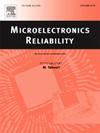SiC功率器件用AMB衬底的耐热耐久性:AlN和Si3N4,哪个耐热强?
IF 1.6
4区 工程技术
Q3 ENGINEERING, ELECTRICAL & ELECTRONIC
引用次数: 0
摘要
在长期可靠性方面,本研究调查了AlN-和Si3N4芯活性金属钎焊(AMB)衬底的耐热耐久性,以证明哪种材料可以更好地用于碳化硅(SiC)电源应用。研究了热冲击循环试验前后AlN-和Si3N4-AMB衬底的界面降解行为、剥离强度和断裂模式。通过对AlN-和Si₃N₄- amb衬底的界面微观结构分析,观察到不同陶瓷类型的钎焊填充金属(BFM)反应层不同。因此,值得注意的是,AlN和Si3N4-AMB衬底在Δ190°C的重复热冲击循环下,在剥离强度测试中分别表现出不同的破坏模式和不同的强度。也就是说,这两种陶瓷型AMB衬底在热冲击耐久性方面存在根本差异。然而,在热冲击试验后,AlN和Si3N4壳体的边缘侧产生的AMB层和陶瓷层之间的裂纹是相同的。这些裂纹是解释剥离强度试验中载荷扩展图的基本原理。本研究系统探讨了以AlN和Si3N4为关键材料的AMB衬底在下一代SiC功率器件中的耐热可靠性。本文章由计算机程序翻译,如有差异,请以英文原文为准。
Heat-resistant durability of AMB substrates for SiC power devices: AlN and Si3N4, which one is thermally strong?
In terms of long-term reliability, the present study investigated the heat-resistant durability of both AlN- and Si3N4 cored active metal brazing (AMB) substrates to demonstrate which material can be a better option for use in silicon carbide (SiC) power applications. Interfacial degradation behaviors, peeling strengths, and fracture modes of the AlN- and Si3N4-AMB substrates were carried out before and after thermal shock cycling tests. The interfacial microstructure analysis of the AlN- and Si₃N₄-AMB substrates observed different brazing filler metal (BFM) reaction layers depending on the type of ceramic. As a result, it was noteworthy that AlN and Si3N4-AMB substrates subjected to repeated thermal shock cycles with Δ190 °C for up to 1000 cycles represented different failure modes with different strength in the peel strength test, respectively. Namely, these two kinds of ceramic type AMB substrates have fundamental differences in thermal shock durability. Nevertheless, cracks between the AMB and ceramic layers were equally caused on the edge side of the AlN and Si3N4 cases after the thermal shock test. These cracks are the underlying principles that explain the load-extension plots in the peel strength test. This study systematically discussed the heat-resistant reliability of AMB substrates with AlN and Si3N4 as key materials for application to next-generation SiC power devices.
求助全文
通过发布文献求助,成功后即可免费获取论文全文。
去求助
来源期刊

Microelectronics Reliability
工程技术-工程:电子与电气
CiteScore
3.30
自引率
12.50%
发文量
342
审稿时长
68 days
期刊介绍:
Microelectronics Reliability, is dedicated to disseminating the latest research results and related information on the reliability of microelectronic devices, circuits and systems, from materials, process and manufacturing, to design, testing and operation. The coverage of the journal includes the following topics: measurement, understanding and analysis; evaluation and prediction; modelling and simulation; methodologies and mitigation. Papers which combine reliability with other important areas of microelectronics engineering, such as design, fabrication, integration, testing, and field operation will also be welcome, and practical papers reporting case studies in the field and specific application domains are particularly encouraged.
Most accepted papers will be published as Research Papers, describing significant advances and completed work. Papers reviewing important developing topics of general interest may be accepted for publication as Review Papers. Urgent communications of a more preliminary nature and short reports on completed practical work of current interest may be considered for publication as Research Notes. All contributions are subject to peer review by leading experts in the field.
 求助内容:
求助内容: 应助结果提醒方式:
应助结果提醒方式:


